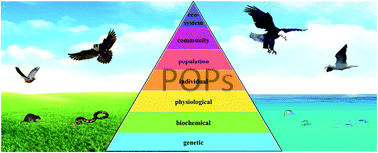Ecotoxicology of persistent organic pollutants in birds†
Abstract
Considering the explosive growth of the list of persistent organic pollutants (POPs), the scientific community is combatting increasing challenges to protect humans and wildlife from the potentially negative consequences of POPs. Herein, we characterize the main aspects and progress in the ecotoxicology of POPs in avian species since 2000. The majority of previous efforts has revealed the global occurrence of high levels of various POPs in birds. Laboratory research and epidemiological studies imply that POPs exert a broad-spectrum of side-effects on birds by interfering with their endocrine, immune and neural system, reproduction, and development, and growth. However, inconsistent results suggest that the potential effects of POP exposure on the physiological parameters in birds are multifactorial, involving a multitude of biological processes, species-specific differences, gender, age and types of compounds. Great progress has been achieved in identifying the species-specific sensitivity to dioxin-like compounds, which is attributed to different amino acid residues in the ligand-binding domain of the aryl hydrocarbon receptor. Besides the conventional concentration additivity, several studies have suggested that different classes of POPs possibly act synergistically or antagonistically based on their concentration. However, ecotoxicology information is still recorded in a scattered and inadequate manner, including lack of enough avian species, limited number of POPs investigated, and insufficient geographical representation, and thus our understanding of the effects of POPs on birds remains rudimentary, although mechanistic understanding of their mode of action is progressing. Particularly, research on what happens to wild bird populations and their ecosystems under POP stress is still unavailable. Thus, our aim is to predict and trace the effects POPs at different biological organization levels, especially from the molecular, cellular and individual levels to the population, community and ecosystem levels because of the limited and scattered information, as mentioned above.

- This article is part of the themed collections: Environmental Science: Processes & Impacts: Recent Review Articles and Best Papers 2021 - Environmental Science: Processes & Impacts


 Please wait while we load your content...
Please wait while we load your content...